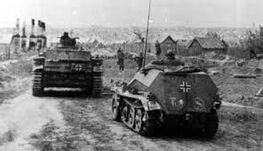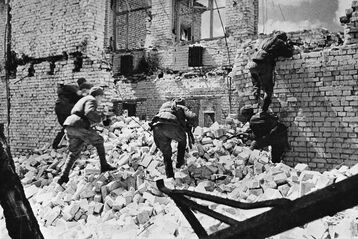The Battle of Stalingrad is generally considered to be one of the decisive victories that led to the defeat of Nazi Germany.
With German casualties around 20,000 men a day, Hitler pulled divisions from other frontlines in the region and sent them in one-by-one. Meanwhile, the Russian leader Josef Stalin committed a million soldiers in the battle, telling his men: “You can no longer retreat There is only one road, the road that leads forward. Stalingrad will be saved by you, or wiped out with you.”
The battle started on August 23, 1942, and ended February 2, 1943, after roughly six months of nearly non-stop fighting. The battle took place in and around the city of Stalingrad, USSR (now Volgograd). It was one of the largest confrontations between the two nations (Germany and the Soviet Union). Both sides were concentrated on success and disregarded losses and the suffering of their military personnel (and even civilians) in order to achieve success.
The Battle of Stalingrad is commonly nicknamed as the "bloodiest battle of World War II" — with an estimated two million casualties. It became one of the most significant events in the course of the war.
Originally, the attack began as a strategic move to capture one of the largest industrial cities in the USSR. After a blitz via the Luftwaffe; much of the city was reduced to rubble, but soon the German advance was mired in urban warfare which was the source of many casualties. The source of the problem for the Wehrmacht was the large group of Soviets clinging to the West bank of the Volga River.
Planning[]
German[]
Hitler chose the industrial city Stalingrad on the Volga River as his next target in the Soviet Union. He did this for a number of reasons; the most obvious one being for the manufacturing plants in the city (it was a major producer of tractors and tanks during the first three Soviet "Five-Year Plans"), and also its strategic positioning as a gateway to the Caucasus oilfields to the south which would replenish German oil resources--nearly depleted as a result of Operation Barbarossa. The capture of these rich oilfields would provide a much needed replenishment and give Germany the ability to turn its attention north, toward Moscow in particular where the Wehrmacht had become immobilised. As a by-product, capturing the city would be a political and propaganda victory for Hitler, as it bears the name of the "vozhd" (вождь, leader (Joseph Stalin).

German tanks ride to Stalingrad.
Prelude[]
Barbarossa[]
Despite the taxing and apparent failure of Operation Barbarossa , Nazi Germany had conquered much Lebensraum in a single swift campaign and the Germans forces had had several successes in the form of Rommel's North African campaign and the U-Boat offensive in the Atlantic. Similarly, the Siege of Leningrad further north had recently stabilised with the help from the Finnish forces. Both Hitler and Stalin were confident in victory, but whilst Hitler was on the offensive in 1942, Stalin was on the defensive - and Hitler was beginning to become arrogant of his ability to direct the military campaign in Russia.
Case Blau (Operation Blue)[]
Operation Blue, the continuation of the earlier failed Operation Barbarossa was a new attempt at defeating the Russian forces by capturing the rich oil fields such as Baku and Grozny. This summer offensive of 1942 was a turning point in the war; Hitler himself claimed "If I do not get the oil of Maikop and Grozny then I must finish this war". This was meant to be achieved through the two different Army Groups; Army Group A intended to cross the Caucasus Mountains, whilst Army Group B protected its flanks across the Volga.
Hitler ordered the 4th Panzer Army outside Stalingrad southward to help the 1st Panzer Army which was already nearing the oil fields. But several days later, news came that the Russians were abandoning Stalingrad and Hitler ordered 4th Panzer Army back to its original positions. Both objectives were now to be taken simultaneously, but the Russians were given sufficient time to reinforce positions south of Stalingrad to slow down the advance of the German armour.
General Halder, Chief of the German Army General Staff, and Field Marshal List, Commander of Army Group A in the Caucasus urged Hitler to capture Stalingrad first using all available forces, before going for the oil fields. They openly criticized the decision and Hitler responded by sacking them and taking over command himself, assuming direct command of all the armies in the Caucasus.
6th Army[]
However, Army Group B--though Blitzkrieg tactics had been successful this far, with support early on from the Luftwaffe-- but eventually had become mired in a building-to-building offensive with a relatively small-scale Russian defense in the city of Stalingrad. This, tied with the diversion of the 4th Panzer Division to the Caucasus (which could have aided the capture of Stalingrad greatly) and the over-extension of Hitler's forces, the Army Group South soon began to suffer from losses and lack of fuel.
Instead of stubbornly defending their positions and inviting complete encirclement, the Russian Army in 1942 had adopted a new strategy, the fighting retreat to minimize losses and draw the German invaders deeper into Russia, thereby overextending the German supply lines. The new panzers, which burned a gallon of fuel per mile, now had to have their motors turned off in order to allow the fuel trucks to catch up, while the supporting infantry had to also fight off partisan attacks.
As his Generals ordered regrouping strategies to counter the new Russian tactics, Hitler concluded that this was defeatism and ordered them to hold their positions. This left the 6th Army and supporting armies vulnerable to attack from the Russians, and they soon found themselves surrounded.
Nevertheless, the 6th Army had fought their way into the city of Stalingrad in September. But this success also brought problems for the experienced German armoured units and assault engineers. The panzer commanders were used to fighting in wide open spaces which allowed for effective maneuvering of tanks and motorized infantry. Stalingrad with a maze of battle-scarred city streets and multi-story buildings restricted movement.
The Battle[]
Luftwaffe[]
The bombing of the city by the Luftwaffe, commanded by Generaloberst Wolfram von Richthofen, was possibly the most devastating blitz in the entirety of the war, the city was turned to rubble. But the attacks only created barriers of blocked streets and broken concrete, serving as good cover for the thousands of Russian infantrymen waiting for the Germans advance.
German allies[]
After the military losses of Barbarossa and garrison duties and anti-partisan warfare in German-occupied Europe, there were not enough young men of military age in Germany to make up for the losses sustained in the invasion of Russia. Therefore Hitler requested that the Axis allied governments send reinforcements to the Eastern Front. As a result, the Wehrmacht received 52 new divisions from Italy, Romania, Hungary, Finland, Slovakia, Croatia and Spain. Their arrival in Russia on paper made up for the earlier losses, but the German generals had their doubts, questioning their training, resolve and leadership.
Soviet forces[]
Although Stalin sent every available support to the city in the form of military, he prevented civilians from leaving the city as a form of emotional blackmail upon his own soldiers - claiming that they would prefer to fight for a "living city" rather than rubble. Though much of the industries were destroyed, some actually continued production, with workers doubling as soldiers when was needed. Production of the Soviet T-34 tank continued despite the fighting, and whilst Germans ran out of supplies rapidly, the Soviets would gather supplies from across the Volga River.
Another main factor for the Russian victory was the sheer determination, stubbornness and heroism on the part of many of the Russian Army officers, NCOs and soldiers. During the so-called "Pavlov's House" fighting, a single platoon under the command of Sergeant Pavlov defended a building that was completely surrounded by Germans, until they were relieved.
The tactic of "hugging the enemy" was conceived by the Commander of the 62nd Army, Vasily Chuikov in an effort to avoid German artillery fire and Luftwaffe attacks. It worked by fighting and staying close to the German units so they could not use fire support, without the serious risk ofof friendly fire.
Stalingrad soon became the site of many heroic Russian charges into the machine guns of the German defenders like a twisted version of what was depicted in Soviet propaganda. Whilst early on, the German Wehrmacht had claimed victory over the devastated city, the German commanders soon realized their mistake; the resistance had become so fierce that it was described as if "thousands of micro battles had erupted". It was the Russians who adopted urban combat tactics well; the Germans were completely unprepared for the urban warfare they were about to experience, the Russians made the best of what cover they could find - making shelter from railway carts, automobiles, etc.

Soviet troops fighting in Stalingrad.
Little Saturn[]
On 16 November 1942, under the cover of fierce blizzard, 13 Russian armies under Marshal Georgi Zhukov attacked the German forward positions outside Stalingrad, attacking the Italian, Romanian and Hungarian divisions from the north and south. In just three days, Russian troops from the north and south fought their way through, thereby encircling the entire 6th Army inside Stalingrad.
Wintergewitter[]
Hitler's new Chief of the Army General Staff, General Kurt Zeitzler, pleaded with the Führer to allow von Paulus to attempt a breakout. But Hitler countered, “I won’t go back from the Volga!” Hitler was confident the Luftwaffe could supply the 6th Army and evacuate the wounded by air and ordered reinforcements under Field Marshal Manstein to advance in Operation Wintergewitter (Winter Storm) and pressure the Russians from the south.
Surrender[]
As the winter weather worsened, thousands of wounded, starving Germans in Stalingrad froze to death. General Zeitzler pleaded Hitler to allow the remnants of 6th Army to attempt a breakout to the south in order to link up with Manstein. But Hitler wouldn't reach an agreement with his subordinates and ordered that Stalingrad be held at all cost.
The Russians assembled seven armies to crush the remaining 20 German divisions in Stalingrad. But before launching their attack, they offered the 6th Army a last chance to surrender and save lives. On 8 January, three Russian officers carrying a white flag presented surrender terms. However, General von Paulus reluctantly turned down the offer. ON 10 January, the Russians bombarded the remaining German defensive lines with 5,000 field guns.
On 17 January, Russian infantry attacked in large numbers. In the close-quarter combat resumed, the Russian units suffered heavy casualties. But time was running for von Paulus. Food and ammunition supplies were critically low. On 24 January 1943, the exhausted Russians offered another opportunity to surrender. This time von Paulus personally intervened and demanded: “Army requests immediate permission to surrender in order to save lives of remaining troops.”
On Sunday 31 January 1943, Russian infantry approached the 6th Army’s command bunker, the cellar of a wrecked department store and Field Marshal von Paulus and his surviving staff were captured, ignoring Hitler’s order that they fight to the last man or commit suicide. Thus the Battle of Stalingrad came to an end.
Out of the 285,000-strong 6th Army, 165,000 were killed in the Stalingrad fighting, while some 29,000 wounded were evacuated by the Luftwaffe. The 91,000 survivors, including 24 generals and 2,500 officers, were marched off to Russian POW camps. Only five thousand would survive the ordeal and return home.
References[]
http://www.historyofwar.org/articles/battles_stalingrad.html
